Comprehensive Guide to Efficient and Effective Storm Damage Repair
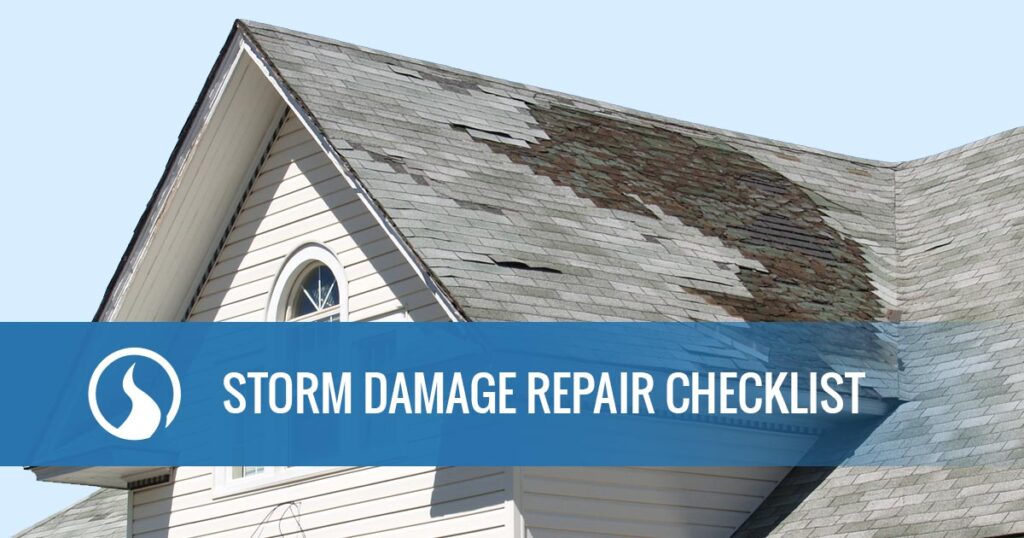
While your roof is designed to last decades, a storm can roll through and cause serious problems for your home. If it’s bad enough, a storm can cause leaks, missing shingles, clogged gutters and more. Any storm damage needs quick repairs to protect you from expensive replacements and the elements. Your roof, gutters, siding, windows and doors all need maintenance and inspection to ensure they’re sealed and secure against violent storms.
When a storm hits, you need to be prepared for damage to happen. While there are ways to help mitigate problems, you can’t stop everything. Having a checklist will help your house quickly and efficiently when big storms happen. Here’s your guide to creating a storm damage checklist and what to watch out for when the weather gets rough.
Types of Storm Damage
Storms — big or small — are made up of many potentially damaging components. While a bit of wind and rain on their own might not seem important, storms can quickly whip them into something dangerous. There are several elements to a storm, all of which have the potential to harm your roof when they blow in.
1. Wind
Wind can be a significant threat when storms roll through. Gale-force winds can be anywhere from 39 to 63 miles per hour, knocking tree branches, shingles and other objects all over the place. While shingles are installed in an overlapping pattern to seal your roof against water damage, wind can rip up shingles and lift and curl them. This exposes your roof to water and can even leave you with whole sections of missing shingles.
Additionally, your roof might take on even larger winds if you live in an area that experiences hurricanes. A Category One hurricane has winds between 74 and 93 miles per hour — that’s the lower end of the scale. Winds at this speed can rip out larger branches and small trees. They might also cause severe damage to roofs, siding and gutters. Anything thrown by these winds might potentially put a hole in your roof, leaving you with a major fix.

2. Standing Water
Standing water might seem harmless at first, but it can quickly become an expensive fix. Standing water is one of the signs of roof damage — any clogs or blocks in your gutters caused by leaves or storm waste will create standing water. If water can’t correctly drain from your roof, it’ll back up into and under the shingles, leaking into the structure below. This backup can get under your roof’s underlayment, permeating your attic and upper floors.
3. Hail
Hailstorms are often brief, but they can still impact your roof. Hail — small lumps of ice created by water droplets carried into the coldest parts of the atmosphere — falls during some thunderstorms.
Since these hard ice balls fall from the sky and can even be propelled by high winds, they have the potential to cause severe damage. They can dent cars, roofs and aircraft — some might break dent your shingles and knock the granules loose. This can weaken your roof’s waterproof barrier and make your home look unappealing.
4. Debris
Storms with high winds are more likely to leave your roof strewn with debris. This debris could include small branches, bits of trash, large tree limbs and even pieces of your roof, gutters or siding. Large objects have a greater chance of penetrating or denting your roof, exposing it to water and wind damage. Lighter, smaller branches might not be as big of a deal, but they can lift shingles or cause granule loss, weakening your roof.
5. Impact
Impact damage can come from lots of things during a storm. Impact damage can be as small as minor dents or as large as holes in your home’s structure.
Debris is a big culprit for impact damage, which is why it’s so important to keep potential debris away from your home. In addition to hail, your roof can take impact damage from trees, objects and even other roof parts. Things blown around by the wind can land on any part of your home — including the roof — and cause a range of issues.
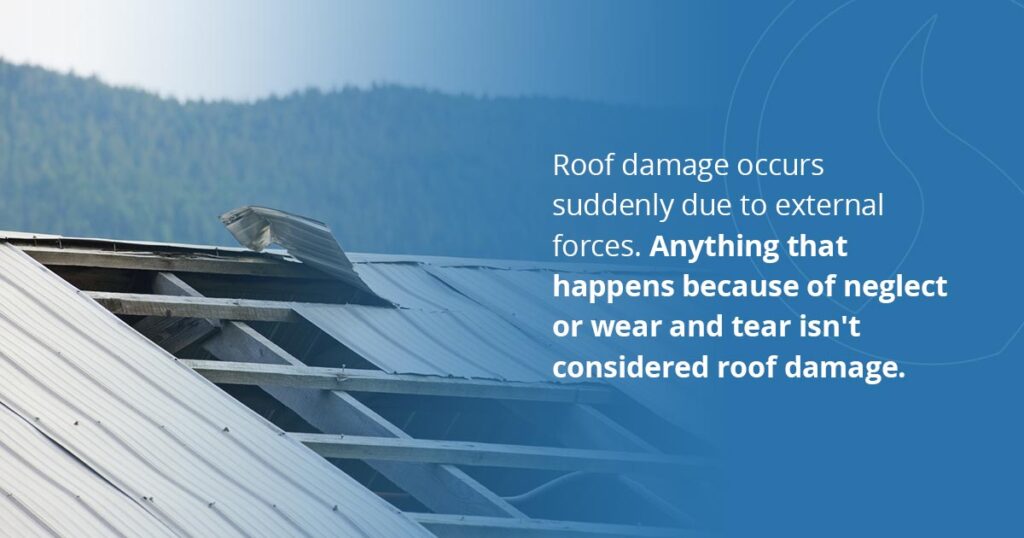
What Is Considered Roof Damage?
Roof damage occurs suddenly due to external forces. Anything that happens because of neglect or wear and tear isn’t considered roof damage.
This distinction is important to understand because wear and tear can lead to weakness in your roof that can make storm damage worse. While any damage sustained by your roof because of the storm is considered roof damage, you might not get as much insurance help if your insurance company determines wear and tear to be partly responsible for your issues.

How to Prevent Storm Damage to Your Roof
While you can’t stop a storm from coming, you can maintain your roof so that it’s as strong as possible. Keeping it in top condition will help it withstand heavy winds and water, reducing your chances of severe roof damage.
Some ways to prevent storm damage include:
1. Trim Trees Near the Roof
Keep tree limbs trimmed back from your house. The closer branches are to your home, the more likely it is they’ll fall on your roof and damage it. Additionally, branches that touch your roof can scrape up against it, damaging your siding and loosening shingles.
Watch out for older, leaning trees — older trees might fall during heavy winds, and dying branches can fall or get blown onto the roof by storms. Ensure no branches hang over your roof, and keep them trimmed back a good distance from your house.
2. Clean the Gutters
Clear your gutters regularly. Leaves and debris can pile up in your gutters over time, reducing their effectiveness and allowing water to back up onto the roof.
Any blockages will worsen during a storm, making it more likely you’ll have standing water issues once the storm passes. Along with roof backups, clogged gutters can cause foundation issues and flooding. Ensure that gutters direct water away from the home and nothing flows back into the foundation.
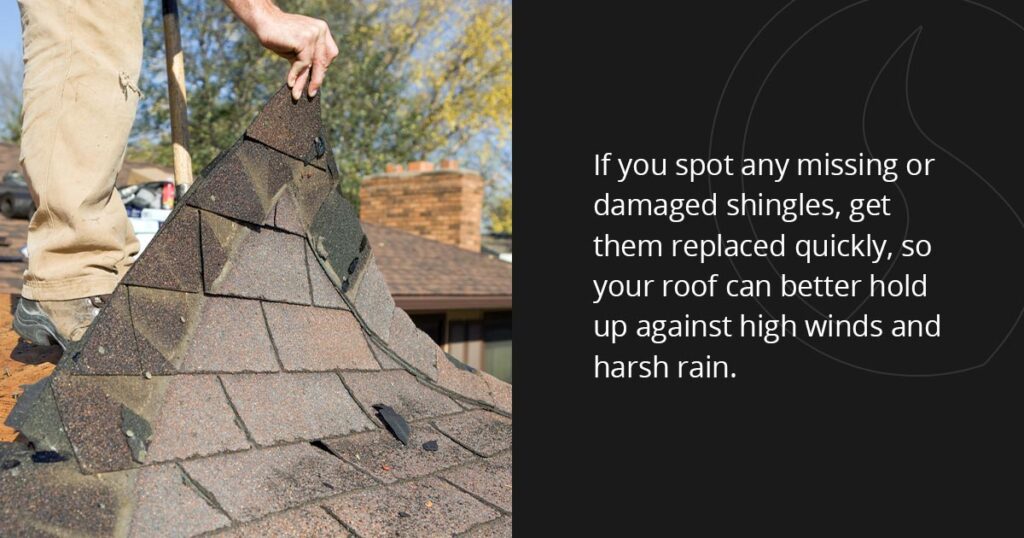
3. Replace Broken Shingles
While you might think a couple of damaged or missing shingles aren’t a huge issue, you’re opening your roof up to severe water damage if you don’t replace them. One weak spot isn’t a problem most of the time, but an intense storm can take that weakness and rip up lots of shingles in the damaged area. If you spot any missing or damaged shingles, get them replaced quickly, so your roof can better hold up against high winds and harsh rain.
4. Repair Siding Damage
Don’t wait for storm damage to get siding repair done — keep your siding maintained to ensure your home’s security during a storm. Loose siding can be further damaged by hail, winds and rain. The stronger and more secure your siding is, the less severe the storm damage will be.
5. Get Regular Maintenance
Maintenance is key to roof strength. Updating your roof will strengthen the overall structure and individual components against damage. Have your roof professionally inspected at least once a year, and always get repairs done by a trustworthy roofing company. They’ll check over the entire roof and ensure everything is safe and durable. Additionally, they’ll inform you of any weak points and repairs you need to make to keep your roof in top condition.
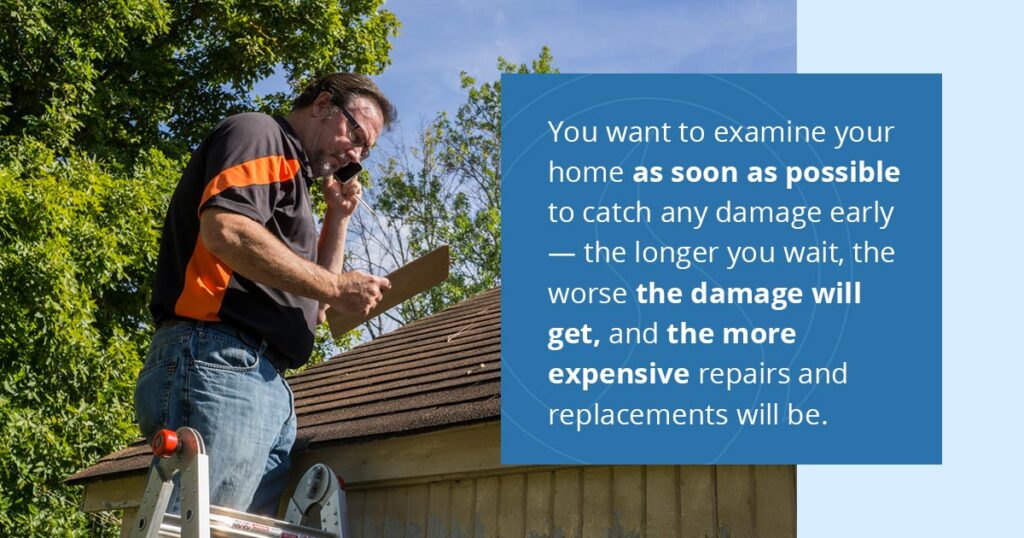
What to Check After a Storm
Once the storm is over, it’s time to check your roof. You want to examine your home as soon as possible to catch any damage early — the longer you wait, the worse the damage will get, and the more expensive repairs and replacements will be. Here’s the storm damage checklist you should follow once the storm has passed:
1. Examine Any Protruding Roof Sections
Start by inspecting any protruding roof parts like skylights and chimneys. These roof sections usually have flashing that redirects water away from the roof’s weak points. Any flashing damage might have let water in. See if there’s any flashing or seal damage, as these will need immediate repair to stop water from penetrating your home.
2. Inspect the Roof Vents
Storms can hurt your roof’s fascia and soffit. These are essential to your home’s ventilation system — once they’re damaged, they can lead to serious problems with your home’s air intake. Don’t ignore damage to roof vents after a storm. If you notice problems, contact a roofer immediately for repairs.
3. Check the Shingles
Exterior shingles will be the most prominent spot to look for damage. While you might be tempted to walk on the roof for a full inspection, you should avoid doing this if possible, as it can be dangerous. Instead, use binoculars to check the shingles on your roof. Try to spot any missing granules or lifted, broken, curled or missing shingles. If you see any, hire a roofer to replace them.
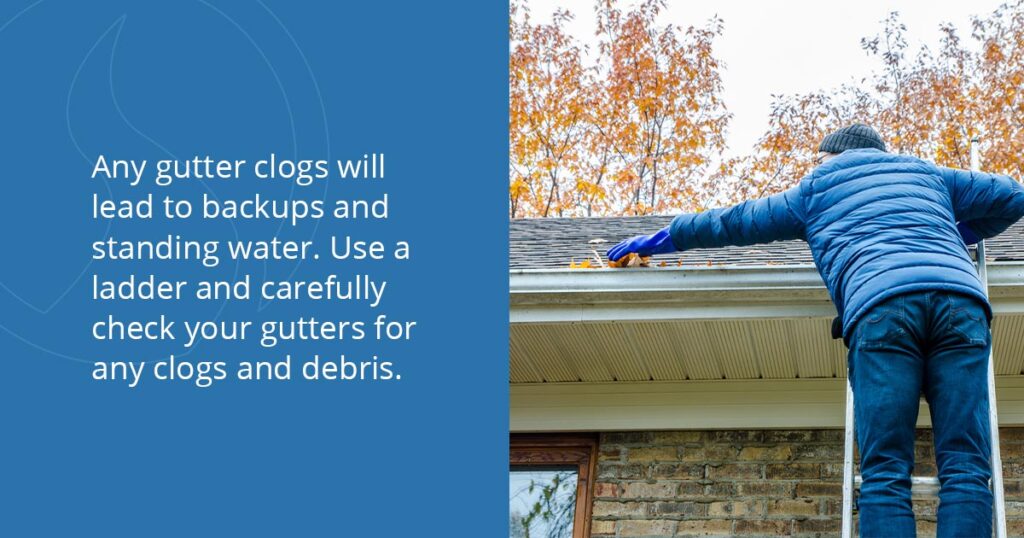
4. Look Over the Gutters
Any gutter clogs will lead to backups and standing water. Use a ladder and carefully check your gutters for any clogs and debris. Remove them as safely as possible. If you don’t feel comfortable unclogging your gutters, you can call someone to clear them for you professionally.
5. Inspect the Ceilings and Attic
Your ceilings and attic are usually the first spots where water damage will show. They’re closest to the roof and the most likely to take on water after a storm. Inspect your upper ceilings and attic carefully, looking for water. Here are some potential signs of a leak to watch for:
- Dripping water
- Shiny surfaces
- Discoloration
- Musty smell
If you spot a leak, you need to contact a roofer as soon as possible — time is of the essence to avoid substantial damage. Get leaks patched up quickly to protect your home.
6. Check Windows and Doors
While windows and doors aren’t part of your roof, they help seal your home just like your roof does. After a storm, ensure none of your windows and doors are loosened or broken. Inspect windows for cracks, especially attic windows you don’t often look at. Look for leaks in upper windows and make sure the weatherstripping and other window components are secure.
7. Examine Outside Areas
Inspect your yard or land and look for anything misplaced by the storm. You’ll want to fix any lawn furniture or decorations that have been thrown around. Additionally, you should take stock of missing fence posts or structures that need replacing. Finally, scan the area for fallen tree limbs. Pick these up and dispose of them to keep the area clean and safe.
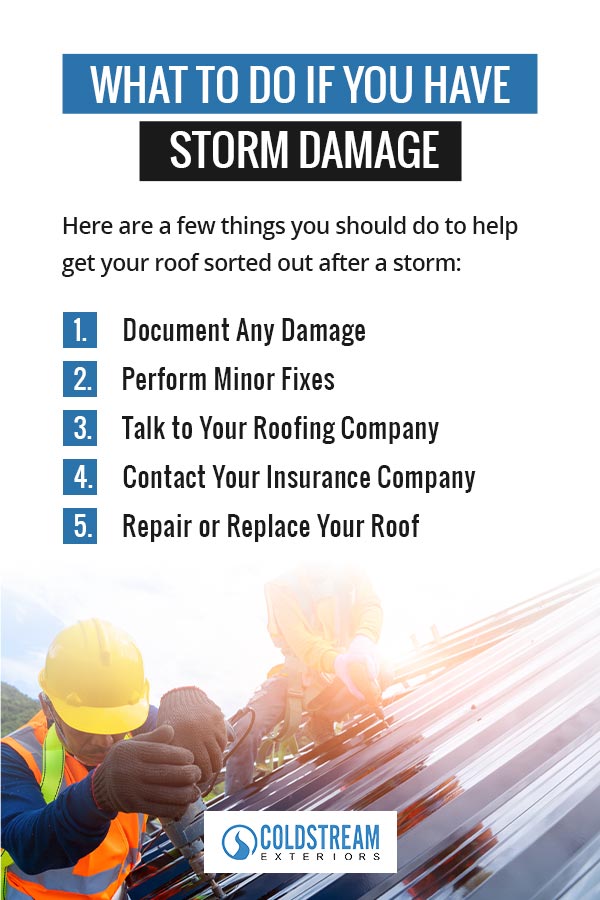
What to Do if You Have Storm Damage
If you’ve examined your home and found that your roof is damaged, you’ll need to act quickly to reduce the costs of repairs. Dealing with post-storm cleanup can be stressful, but taking action is important to ensure your home isn’t further damaged. Here are a few things you should do to help get your roof sorted out after a storm:
1. Document Any Damage
While getting your roof fixed is essential, you’ll want to document any damages before fixing them, so you have proof for insurance. Whether you’re filing an insurance claim now or will need to file one in the future, having evidence of prior damage and a record of any roof fixes will go a long way toward helping your insurance claim.
Take pictures of any missing shingles, clogged gutters, leaks, holes, branches, loose siding and any other issues caused by the storm. This way, you’ll have proof that the storm caused the problems. Having pictures of everything will help you keep track of all the damage and make it easier for roofers to know what they’re dealing with before their inspection.
2. Perform Minor Fixes
Patch up anything as best you can before professional help arrives, especially if there’s damage that will directly interfere with normal life at your house. Put buckets under holes or leaks to catch any water and move non-waterproof items and other valuables away from any moisture to protect them from damage. If you have a severe hole or leak, you can put up a piece of tarp to keep as much water, wind and sun out as possible.
3. Talk to Your Roofing Company
Talk to a trustworthy, high-quality roofing company to help you with your roof inspection and repairs. Getting a roofer’s written inspection of the damage and what needs to be done will help you out when you file your insurance claim. Additionally, the roofer might look at your roof and let you know you only need a few minor repairs instead of major repairs or a roof replacement. In that case, it might be easier to just get the repair instead of going through insurance.
Insurance can often help when you’re dealing with storm damage, but you’ll always want to use a separate contractor to get a second opinion. When it comes to storm damage repair in Cincinnati and St. Louis, contractors are experts at assessing and repairing the damage. Insurance will help you out after you submit a claim, get an adjuster’s assessment and have your claim approved, but a trusted contractor will have your interests as their top priority. Work with them to get documented repairs that boost your chances of an approved claim.

4. Contact Your Insurance Company
If your roof has sustained considerable damage after a storm, you’ll probably need to get insurance involved. Filing an insurance claim can help you get a roof repair or replacement fully covered by your insurance company. You’ll want to review your policy to see if your insurance covers your roof damage, but don’t wait too long to submit your claim — if you don’t file quickly enough, your claim might get denied.
5. Repair or Replace Your Roof
Once you’ve surveyed and documented your roof and contacted professionals, it’s time to get it fixed. Your roofer will let you know if you should get your roof repaired or replaced, which can greatly affect your total costs.
In most cases, roof repairs work well for newer roofs with minor damage. However, you might consider investing in a roof replacement in St. Louis or Cincinnati if you have a roof that’s around 20 years old. Upgrading your roof can leave you with fewer long-term repairs and better protection against storms and damage.
On the other hand, repairs are often less expensive and quicker. A good repair will leave your roof secure against the elements without the commitment of a full replacement. This is ideal for homes that are only missing shingles or have other minor issues after a storm.
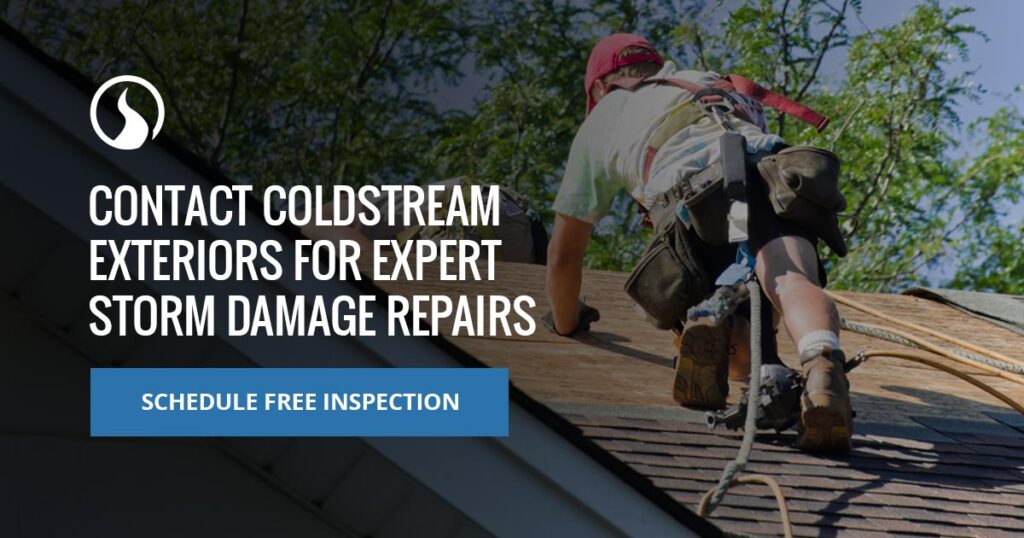
Contact Coldstream Exteriors for Expert Storm Damage Repairs
Don’t let storms weaken your home — use an experienced roofing company to keep your roof in top condition. If you live in the Cincinnati, Tampa or St. Louis area, your home is potentially exposed to storms, snow or hurricanes. We offer expert roofing repair and replacement along with high-quality window, siding and gutter services.
With over 20 years of experience, you can trust our team to deliver premier roofing services at affordable rates. We understand how essential quality, efficient roofing work is, which is why we offer 0% and low-interest financing. With over 10,000 projects completed and an A+ Better Business Bureau rating, you can expect the best when you work with Coldstream Exteriors.
Whether you need replacements, installation or storm damage repairs in St. Louis or Cincinnati, fill out our form online and get your free estimate today.
